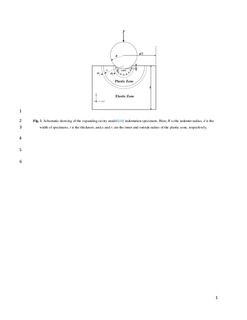| dc.contributor.author | Zhao, Kai | |
| dc.contributor.author | Mayer, A. E. | |
| dc.contributor.author | He, Jianying | |
| dc.contributor.author | Zhang, Zhiliang | |
| dc.date.accessioned | 2018-12-12T09:40:34Z | |
| dc.date.available | 2018-12-12T09:40:34Z | |
| dc.date.created | 2018-09-01T22:26:27Z | |
| dc.date.issued | 2018 | |
| dc.identifier.citation | International Journal of Mechanical Sciences. 2018, 148 158-173. | nb_NO |
| dc.identifier.issn | 0020-7403 | |
| dc.identifier.uri | http://hdl.handle.net/11250/2577309 | |
| dc.description.abstract | Understanding plasticity initiation and evolution in nanoindentation tests is a fundamental issue. In this study, a continuum model is developed to analytically predict the force-depth curve by coupling the classical Hertzian solution for elastic field and the evolution of dislocation density. By considering multiple slip systems, the present model predicts the “pop-in” event well. Large-scale molecular dynamics simulations are performed to evaluate the mechanical behavior of bcc Fe under nanoindentation of a spherical indenter and to verify the continuum model. The comparison between molecular dynamics simulations and model predictions shows that the initiation and evolution of dislocation networks is strongly dependent on the loading orientation, which is associated with different deformation patterns. Applying the transition state theory, we investigate the slip-twinning transition as a function of loading rate, which supports the basic hypothesis in the continuum model that the activation of shear loop requires lower energy compared with twin nucleation, although twins can nucleate temporally and annihilate into shear loops finally. The present model provides a general framework to evaluate and rationalize the “pop-in” behavior of any materials with elastoplastic response. | nb_NO |
| dc.language.iso | eng | nb_NO |
| dc.publisher | Elsevier | nb_NO |
| dc.title | Dislocation based plasticity in the case of nanoindentation | nb_NO |
| dc.title.alternative | Dislocation based plasticity in the case of nanoindentation | nb_NO |
| dc.type | Journal article | nb_NO |
| dc.description.version | submittedVersion | nb_NO |
| dc.source.pagenumber | 158-173 | nb_NO |
| dc.source.volume | 148 | nb_NO |
| dc.source.journal | International Journal of Mechanical Sciences | nb_NO |
| dc.identifier.doi | 10.1016/j.ijmecsci.2018.08.038 | |
| dc.identifier.cristin | 1606032 | |
| dc.relation.project | Notur/NorStore: NN9391K | nb_NO |
| dc.relation.project | Notur/NorStore: NN9110K | nb_NO |
| dc.relation.project | Norges forskningsråd: 234130 | nb_NO |
| dc.description.localcode | This is a submitted manuscript of an article published by Elsevier Ltd in International Journal of Mechanical Sciences, 31 August 2018 | nb_NO |
| cristin.unitcode | 194,64,45,0 | |
| cristin.unitname | Institutt for konstruksjonsteknikk | |
| cristin.ispublished | true | |
| cristin.fulltext | preprint | |
| cristin.qualitycode | 1 | |
